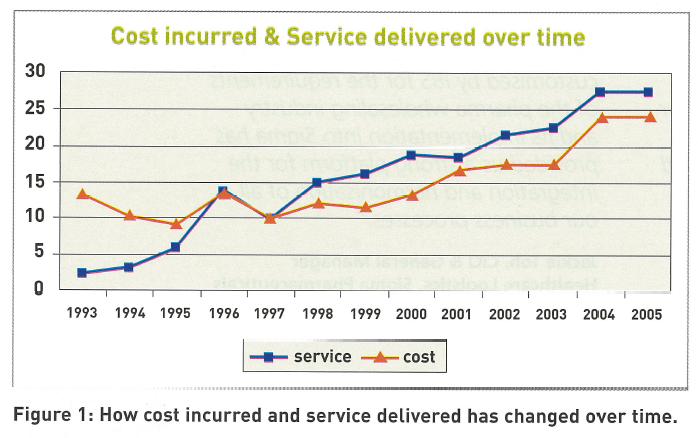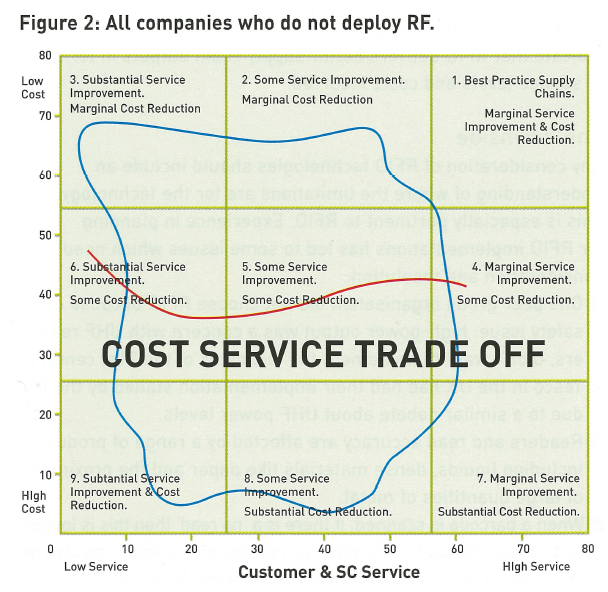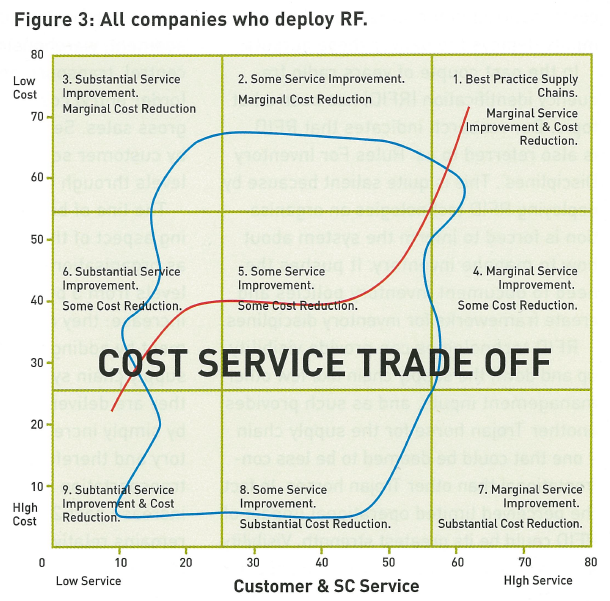by Stephen Hanman (As seen in MHD Supply Chain Solutions)
Benchmarking Success (BMS) has been gathering supply chain intelligence since 1993. This data gathering process has enabled development of a best-practice supply chain model that compares the outputs of services delivered to the customer and along the supply chain, and the costs incurred to deliver that service with the business inputs deployed to deliver those outputs.
The SCAR report is developed after a company completed the diagnostic process and has the model applied. The business inputs that are part of this model include:
- Business plants
- Strategic evaluation tools (pareto analysis, product port folio, ect.)
- KPIs (development and deployment of)
- Structure and responsibility
- Enabling systems (ERP, RF, WMS, etc.)
- Supply Chain relationships
What has happened to supply chain performance since 1993? With all the focus on supply chain, what has actually changed?
In early 2006, BMS did an analysis of the data on a year-on-year basis. Figure 1 shows a comparison of improvements in actual service delivered across the supply chain with the cost reductions achieved over the same period. The vertical axis measures the actual average scores achieved from all supply chains from our best-practice model, and compares service and cost improvements over the years. The average service has improved from less than 5 to above 25 while the cost score started at about 12 and has increased to about 24 (indicating a reduction in costs).
Figure 1 illustrates how supply chains have evolved from a cost-focused strategy in 1993, costs were low but so were service levels in the supply chain. Service improvements have outstripped cost reductions from 1993 to 2005. The ‘Holy Grail’ has been achieved by many: service levels go up while the cost base reduces.
The data indicates that over the past 15 years supply chain management has become more strategic, with the challenge being to balance service and cost.
To create long lasting change, many organisations create a ‘Trojan Horse’ to drive supply chain development. Ask yourself, what is your organisation’s Trojan horse? This approach suggests that you create a focal point for improvement. It should enable a rethink on how the whole supply chain is managed and provide a motivation to continually improve performance.
Our research from our peer groups indicates that the Trojan horse changes, depending on the organisation, could be:
- DIFOT (delivery in full and on time) or perfect order,
- an ERP implementation,
- S&OP (sales and operations planning),
- people management, or
- the cash cycle
The role of radio frequency technology
Let us now move down from the total supply chain and look at the warehouse, and consider the question: what value does RFID technology deliver to performance? This analysis is possible because the BMS diagnostic process asks for actual service levels delivered and costs incurred in the warehouse and the inputs deployed to deliver those outputs.
In the past couple of years radio frequency (RFID) has been a hot topic. Our research indicates that RFID is also referred to as ‘Rules For Inventory Disciplines’. This is quite salient because by deploying RFID technologies an organisation is forced to inform the system about how to manage inventory. It pushed the need to document inventory policies and create frameworks for inventory disciplines.
RFID technologies can provide visibility up and down the supply chain like few other management inputs, and as such provides another Trojan horse for the supply chain – one that could be deemed to be less confrontational than other Trojan horse. In fact, the perceived limited operational impact of RFID could be its greatest strength. Visibility and transparency provide significant opportunities for integrated management – the Holy Grail for world class performers.
To assess the value of RFID technologies on the supply chain, BMS created comparisons from its 700-strong database between organisations that deploy RFID technologies and those that do not. Is there a discernible difference in supply chain outputs between these two groups?
Figure 2 illustrates the service and cost performance for companies from all industries that do not deploy RFID. The cloud represents the spread of data points between service and cost performance, while the line through the cloud is the line of best fit through all the data points.
Logistics or supply chain costs incorporate purchasing admin, inventory management, warehousing (DC=distribution centre), transport, and customer service (order entry) costs as a percentage of gross sales. Service points are determined by customer service levels and service levels through the supply chain.
The line of best fit is the most interesting aspect of this figure. It suggests that as organisations improve their service levels from 5 points to 25 points, costs increase: they achieve service improvement by adding to the cost base of the supply chain system. (This may be because they are delivering higher service levels by simply increasing the amount of inventory and therefore increasing the DC and transportation costs). As the service levels increase past 25 points, the cost base remains relatively stable. Any organisation that achieves 60 service points or more does this with a relatively high cost base. In contrast, Figure 3, illustrates service and cost performance for all supply chain that utilise RFID technologies. As the figure highlights, the clouds are similar in shape but the lines of best fit through these data points are significantly different.
This suggests that as organisations improve their service levels from 5 points to 25 points, costs reduce (e.g. can be explained by less claims, less errors in order entry, less errors, in DC, etc.). Costs are then relatively flat as service levels increase to 45 points.
A significant change in the line then occurs after service points of 45 up to 60 points: costs reduce dramatically as service improves. The theory behind this outcome is that very few organisations live on the inventory investment and service fill line, relating to the ‘Holy Grail’ mentioned in Figure 1. They operate above the line so they can achieve service improvement and cost reduction simultaneously.
So in comparison to no RFID technology, the RFID supply chains achieve higher service levels at a lower cost base. An RF-based supply chain can deliver higher service levels for a lower overall cost when compared to non-RFID supply chains.
Further explanations about the cloud in Future 3, could follow along the lines that the most progressive supply chains would be the ones who have deployed RFID technologies. How significant is the deployment of RFID technologies when compared to other business inputs deployed to deliver supply chain outputs of service delivered and costs incurred?
BMS conducted statistical analysis to assess the relationship between the RFID technologies input and the outputs of service delivered and costs incurred.
Our analysis indicates that:
- Picking accuracy is statistically higher in the RFID DC (distribution centre) than in the non-RFID DC.
- Time to unload and receipt product is faster for the RFID-based DC. This makes sense and supports the results in point one above. When product is unloaded and receipted, it is available for sale even though it still may be sitting in a waiting area for put-away.
- Inventory record accuracy (IRA) is the most significant difference between RFID and non-RFID supply chains.
- Delivery in-full by unit to the customer relates to service post the DC. The order leaves the DC and is then transported and unloaded at the customer. The BMS data indicates that the RFID DC dataset delivers higher in-full delivery to the customer. The explanation could be that fewer errors occurs because of the transparency and visibility that RFID technology offers. Trucks are loaded and unloaded more accurately.
- DC costs as a percentage of gross sales indicates that an RFID DC is marginally less costly than a non-RFID DC. The gap is more pronounced for more complex supply chains that have a SKU complexity and split cases. This indicates that the cost of the technology more than pays for itself.
- Cost per line-item picked also costs less for the RFID DC compared to the non-RFID DC. This picking productivity KPI incorporates total DC costs covering all activities in the DC (receipting, put-away, pick and despatch).
- Inventory obsolescence is defined as inventory that has not moved for six months. An RFID DC can enable better management of inventory and ensure it is ready and fit for purpose when required. Inventory obsolescence is less for the RFID DC.
Overall, this data supports the cloud diagrams earlier that indicate that RFID delivers better supply chain outputs in terms of service levels and costs incurred.
The downside
Any consideration of RFID technologies should include an understanding of where the limitations are for the technology. This is especially pertinent to RFID. Experience in planning for RFID implementations has led to some issues which need consideration and resolution:
- One peer group organisation did not choose RFID because of a safety issue: high-power output was a concern with UHF readers, didnt’ want to implement the ‘asbestos of the 21st century’.
- Tesco in the UK had had their implementation stalled by the EU due to a similar debate about UHF power levels.
- Readers and read accuracy are affected by a range of products including liquids, dense materials like paper and the proximity of large quantities of metal.
- When a barcode is scanned, if there is a ‘no read’ then this is logged and can be reacted to promptly. The number of ‘no reads’ can also be seen and analysed. The same process is needed for RFID.
- RFID tags can create large amounts of data which then needs to be processed. Implementers need a clear understanding of what data is required and how data support systems will process and deploy this information to enhance supply chain decision making.
Conclusion
BMS research indicates that RFID implementation has delivered improved supply chain service levels while reducing the cost based to deliver that service level.
Through analysis of the BMS database, peer group processes and literature research it is clear that the introduction of RFID technology can:
- Increase service performance.
- Reduce warehouse and inventory costs.
- Improve inventory accuracy and availability.
- Provide a catalyst for improvements in wider supply chain processes.
- Reduce waste across the supply chain.
However there are risks, as there are with any new technology implementation. The extent to which the benefits are realised will depend on the current supply chain performance levels and organisational development. Another key driver will be the effective management of the review and change processes deployed.



